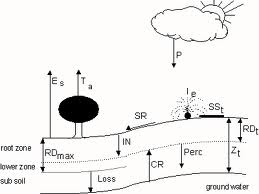There is an important new regional climate model paper (using type 3 downscaling as defined in
Pielke Sr., R.A., and R.L. Wilby, 2012: Regional climate downscaling – what’s the point? Eos Forum, 93, No. 5, 52-53, doi:10.1029/2012EO050008.
The new paper is
Xue, Y., R. Vasic, Z. Janjic, Y. M. Liu, and P. C. Chu (2012), The impact of spring subsurface soil temperature anomaly in the western U.S. on North American summer precipitation: A case study using regional climate model downscaling, J. Geophys. Res., 117, D11103, doi:10.1029/2012JD017692.
The abstract reads [highlight added]
This study explores the impact of spring subsurface soil temperature (SUBT) anomaly in the western U.S. on North American summer precipitation, mainly southeastern U.S., and possible mechanisms using a regional climate Eta model and a general circulation model (GCM). The GCM produces the lateral boundary condition (LBC) for the Eta model. Two initial SUBT conditions (one cold and another warm) on May 1st were assigned for the GCM runs and the corresponding Eta runs. The results suggest that antecedent May 1st warm initial SUBT in the western U.S. contributes positive June precipitation over the southern U.S. and less precipitation to the north, consistent with the observed anomalies between a year with a warm spring and a year with a cold spring in the western U.S. The anomalous cyclone induced by the surface heating due to SUBT anomaly propagated eastward through Rossby waves in westerly mean flow. In addition, the steering flow also contributed to the dissipation of perturbation in the northeastern U.S. and its enhancement in southeastern U.S. However, these results were obtained only when the Eta model run was driven by the corresponding GCM run. When the same reanalysis data were applied for both (cold and warm initial SUBT) Eta runs’ LBCs, the precipitation anomalies could not be properly produced, indicating the intimate dependence of the regional climate sensitivity downscaling on the imposed global climate forcing, especially when the impact was through wave propagation in the large-scale atmospheric flow.
Excerpts from the conclusion reads
This study demonstrates that although GFS runs with large internal variability and coarse resolutions were unable to produce adequate precipitation difference patterns, the downscaling of GFS precipitation output using Eta did yield significant results consistent with observations.
The Eta results were obtained only when we used GFS outputs for the corresponding Eta runs’ LBCs. When we applied the same reanalysis data for both (control and sensitivity) Eta runs’ LBCs, the Rossby wave propagation was suppressed and observed precipitation anomalies were not properly produced. Because large scale circulation and low-level moisture transfer played crucial roles in proper simulations of the U.S. summer precipitation, maintaining the same LBC produced similar large-scale patterns, causing severe limitations in this sensitivity study. Downscaled regional climate is closely linked to the imposed global climate forcing. Therefore, for climate sensitivity studies using RCMs, consistent lateral boundary forcing may be crucial, especially when the impact is produced through wave transference in the atmosphere.
This is the first modeling study to explore the western U.S. SUBT impact and its teleconnections with Eastern U.S. precipitation. The results suggest that SUBT may be able to provide an extended element of memory, which would enhance predictability. However, there are many issues which require more investigations……
The Xue et al 2012 paper also confirms what we presented in
Pielke Sr., R.A., G.E. Liston, J.L. Eastman, L. Lu, and M. Coughenour, 1999: Seasonal weather prediction as an initial value problem. J. Geophys. Res., 104, 19463-19479.
The abstract of our paper reads
Using a climate version of a regional atmospheric model, we show that the seasonal evolution of weather is dependent on the initial soil moisture and landscape specification. Coupling this model to a land-surface model, the soil moisture distribution and landscape are shown to cause a significant nonlinear interaction between vegetation growth and precipitation. These results demonstrate that seasonal weather prediction is an initial value problem. Moreover, on seasonal and longer timescales the surface characteristics such as soil moisture, leaf area index, and landcover type must be treated as dynamically evolving dependent variables, instead of prescribed parameters.


